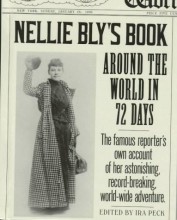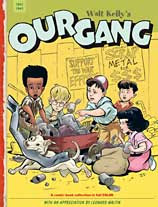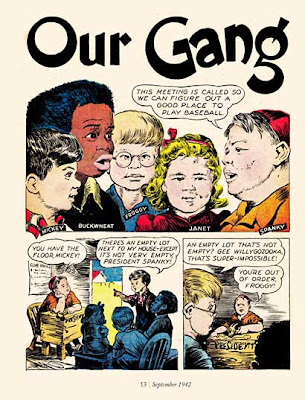by Matt Phelan Candlewick 2011 Three remarkable journeys made by a trio of intrepid adventurers – Thomas Stevens, Nellie Bly, and Joshua Slocum – on the eve of the 20th century, rendered in graphic novel format. As a prologue, we begin with the wager that sets up Jules Verne's Around the World in 80 Days. It seems an impossible (and almost arbitrary) goal to set, but fantastical enough
Viewing: Blog Posts Tagged with: nellie bly, Most Recent at Top [Help]
Results 1 - 4 of 4
Blog: The Excelsior File (Login to Add to MyJacketFlap)
JacketFlap tags: adventure, graphic novel, matt phelan, nellie bly, candlewick, sailing, bicycling, 11, thomas stevens, joshua slocum, Add a tag
Blog: OUPblog (Login to Add to MyJacketFlap)
JacketFlap tags: trip, journalism, This Day in History, jules verne, women's history, nellie, *Featured, higher education, this day in world history, around the world in 72 days, around the world in eighty days, elizabeth cochran, new york world, pulitzer’s, sampans, phileas, burros, rickshaws, bly’s, travel, History, Literature, US, World, nellie bly, Add a tag
This Day in World History
November 14, 1889
Nellie Bly begins record round-the-world trip
 At 9:40:30 in the morning of November 14, 1889, an American woman began a trip abroad. It was not just any trip, though: journalist Nellie Bly was out to best the legendary journey of Phileas Fogg, the British gentleman who was the hero of Victor Hugo’s bestselling novel, Around the World in Eighty Days. Bly’s whirlwind world trip was heavily promoted by Joseph Pulitzer’s newspaper the New York World.
At 9:40:30 in the morning of November 14, 1889, an American woman began a trip abroad. It was not just any trip, though: journalist Nellie Bly was out to best the legendary journey of Phileas Fogg, the British gentleman who was the hero of Victor Hugo’s bestselling novel, Around the World in Eighty Days. Bly’s whirlwind world trip was heavily promoted by Joseph Pulitzer’s newspaper the New York World.
Born Elizabeth Cochran, the writer who became Nellie Bly became a journalist at 21 when she wrote a letter to the editor of a Pittsburgh paper complaining about his dismissive statements about women in the workplace. Impressed by her writing, he hired her. She gained fame from a series of articles describing corruption and poverty in Mexico, leading the outraged Mexican government to force her to leave the country. Working for Pulitzer’s World, she had herself committed to an insane asylum and then wrote a searing exposé of horrible conditions there. The articles prompted a government investigation.
Bly proposed the round-the-world trip in 1888, but the World demurred initially at having a woman make the journey. Once she left, though, the paper covered the story to the hilt, even running a contest to have viewers guess her return date. Almost a million entries were received. Using steamships and sampans, trains and rickshaws, horses and burros, Bly made rapid time—although she did stop in Paris to meet Verne and his wife. She finished her journey 72 days, 6 hours, and some minutes after her departure. She described the scene: “The station was packed with thousands of people, and the moment I landed on the platform, one yell went up from them, and the cannons at the Battery and Fort Greene boomed out the news of my arrival.”
“This Day in World History” is brought to you by USA Higher Education.
You can subscribe to these posts via RSS or receive them by email.
Blog: I.N.K.: Interesting Non fiction for Kids (Login to Add to MyJacketFlap)
JacketFlap tags: Sue Macy, All-American Girls Baseball, underdogs, Annie Oakley, Super Bowl, Nellie Bly, Super Bowl, All-American Girls Baseball, underdogs, Annie Oakley, Nellie Bly, Add a tag
As an author who writes about sports and women’s history, I have a soft spot for underdogs. Indeed, most of the people I write about were underdogs who triumphed, defying expectations and social mores to make their mark in the world. Annie Oakley first came to fame by defeating her future husband in a shooting exhibition she was expected to lose. The women of the All-American Girls Professional Baseball League (AAGPBL) staked their claim to the American pastime despite an initially skeptical public. Nellie Bly, the subject of one of my next books, broke into New York’s old boy newspaper network despite editors who came right out and told her they wouldn’t trust a woman to cover anything but society events.
Underdogs make good stories, especially when the readers are kids, who often feel disenfranchised themselves. If they can see their struggles reflected in those of the people in my books, the past suddenly seems relevant, and reading about history isn’t a turnoff. And the points of identification don’t have to be obvious. While girls have embraced the female baseball players of the AAGPBL, I often find that boys are more animated and ask more questions when I give talks about the league. Boys who play sports relate to the women as athletes, and love the opportunity to measure their own experiences against those of the Chicks, Peaches, and Daisies.
Fortunately for both authors and readers, history is full of victorious underdogs whose lives and deeds are ripe for examination. Patriots fans can even take heart that in 1781, the ragtag Revolutionary War soldiers who inspired the name of their modern-day football team came away with a clutch victory against the giants of
Blog: AmoxCalli (Login to Add to MyJacketFlap)
JacketFlap tags: graphic novel, comics, Hal Roach, Our Gang, Walt Kelly, Add a tag

Walt Kelly’s Our Gang. Vol. 1, 1942-1943
Author: Walt Kelly
Publisher: Fantagraphics Books
ISBN 10: 1-56097753-1
ISBN 13: 978-1-56097753-7
Walt Kelly is famous for his now-classic Pogo newspaper comic strip from 1948 until his death in 1973. Most cartoon fans know that Kelly began as an animator for Walt Disney, and that he wrote and drew funny-animal and fairy-tale comic books from 1941 until 1948. He actually began Pogo in comic-book form in 1941. Much of Kelly’s comic-book art has been reprinted over the last two decades, especially his Disney comics covers showing Mickey Mouse and Donald Duck in his own art style.
Kelly also wrote and drew a human comic-book series during the 1940s, around the Our Gang children film stars. Movie historian Leonard Maltin describes in an introductory “appreciation” how Dell/Western Publishing licensed in 1942 the rights to produce a comic book featuring all the MGM movie short series like the Tom & Jerry cartoons, and they chose the Our Gang stories to lead off the comic book – and hired cartoonist Kelly to produce them. MGM had bought Our Gang from the Hal Roach Studio in 1938, and by 1942 had lost interest in them, so Kelly had the creative freedom to interpret the kids in his own way. The 8- to 14-page stories in these first eight issues were very close to MGM’s last Our Gang one-reelers, based on publicity stills of the child actors and following the movies’ stereotypes. Maltin, and Kelly collector-historian Steve Thompson in his introduction, promise that later stories of the 59 in the series will show how Kelly evolved, having the movie Gang grow older and be replaced with new characters who were Kelly’s own, with realistic personalities rather than stereotypes.
This collection has several laudable goals: to show that Kelly could create excellent realistic human-character stories as well as funny-animal humor; to restore a missing dimension of the Our Gang works for those movies’ fans; and to present a nostalgic glimpse of children’s lives in America in the 1940s. As Steve Thompson says, “Not for them the over-organized and regimented sports, dance and music activities of today’s youth. In those days before ‘stranger danger’ and almost daily reports of child abductions, in all but the largest cities during summer, kids could disappear after breakfast, possibly return for lunch, and then vanish again until supper, without panicking their parents.” (I can confirm this. I am in my late sixties now, and I grew up in Los Angeles rather than an Eastern small town, but I had the same juvenile freedom to just “mess around” outdoors all day with my playmates as long as we stayed out of trouble.) It may be personal nostalgia for my own youth, but I found Walt Kelly’s Our Gang vol. 1 to be thoroughly delightful.



